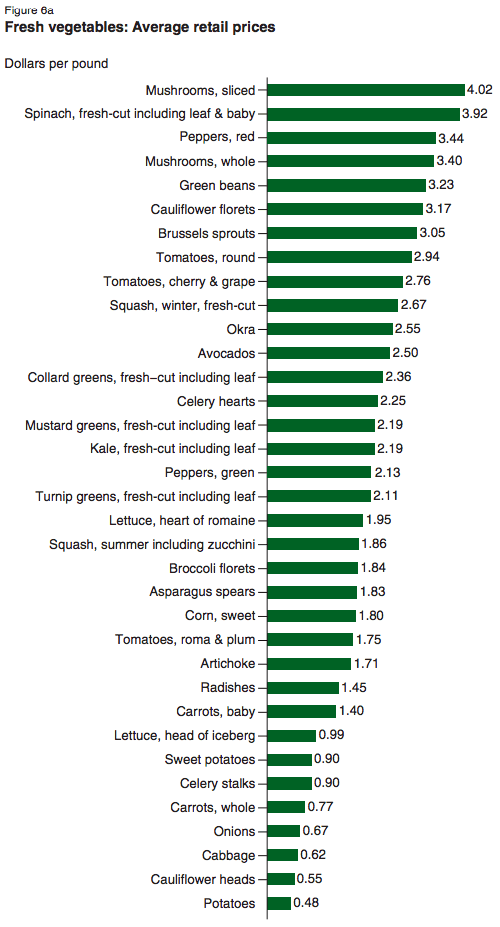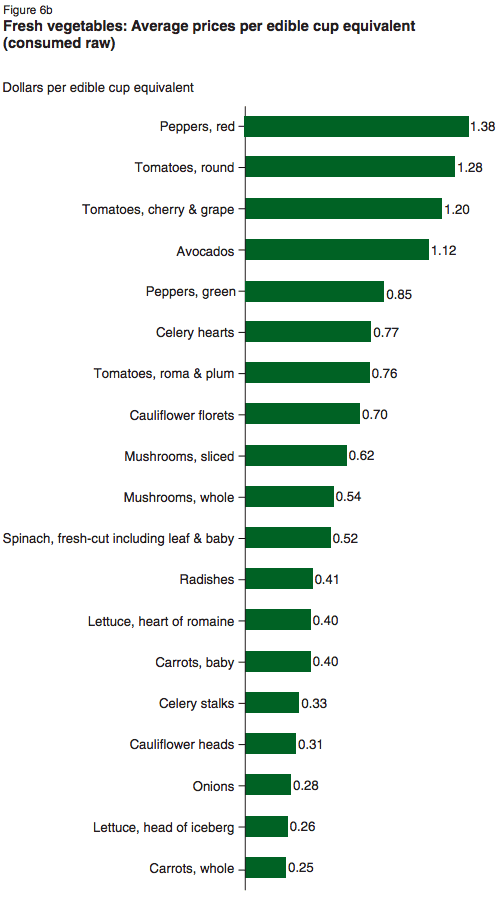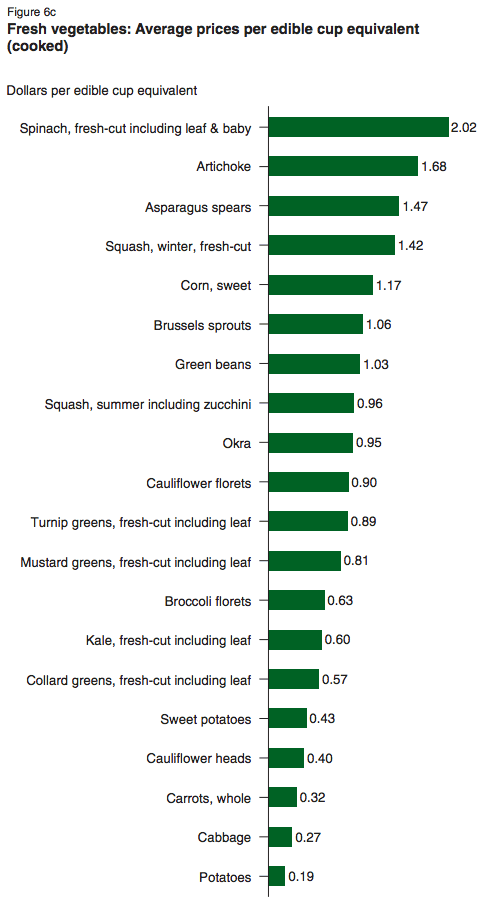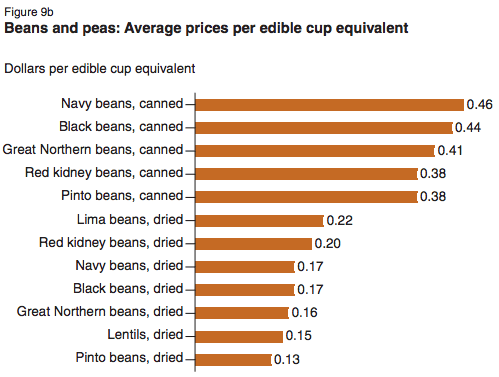While doing research about getting the most nutrition for my dollar, I ran across an interesting report from the U.S. Department of Agriculture called How Much Do Fruits and Vegetables Cost? [pdf]. The overall goal of the study was to better understand why Americans don’t eat the recommended amount of fruits and vegetables. Here are some neat charts of vegetables ranked by price per pound, as well as ranked by cost per edible cup equivalent:



Legumes and pulses like beans, lentils, and peas were considered separately. Here’s their chart, ranked by edible cup equivalent:

There are more charts in the full study, covering canned fruits and so on. Here are a few of their major findings:
- An adult on a 2,000-calorie diet could satisfy USDA recommendations for vegetable and fruit consumption for around $2 to $2.50 per day. This accounts for both amount and eating a variety of fruits and vegetables.
- Canned or frozen fruits and vegetables were not consistently more or less expensive than fresh produce. For example, canned carrots (34 cents per edible cup equivalent) were more expensive than whole fresh carrots eaten raw (25 cents per edible cup equivalent), but for peaches the opposite was true.
- You shouldn’t just compare prices per pound, as the amounts may shrink after cooking and removing inedible parts. For example, fresh broccoli florets and fresh ears of sweet corn both sold for around $1.80 per pound at retail stores. After boiling and removing inedible parts, however, the sweet corn cost almost twice as much as the broccoli florets ($1.17 vs. 63 cents per edible cup equivalent).
I actually discovered this information after purchasing the ingredients on my $1.50 a day menu, but my trips to the grocery store and ethnic food markets resulted in similar conclusions. The dried pinto beans, dried lentils, carrots, and onions that I ended up choosing were all amongst the cheapest vegetables in the study (while still providing plenty of nutrition!). Cauliflower, potatoes, and cabbage would have also been good choices. It would be interesting to have some sort of ranking based on nutritional value, but that would be hard to simplify down to a single number.
 The Best Credit Card Bonus Offers – October 2024
The Best Credit Card Bonus Offers – October 2024 Big List of Free Stocks from Brokerage Apps
Big List of Free Stocks from Brokerage Apps Best Interest Rates on Cash - October 2024
Best Interest Rates on Cash - October 2024 Free Credit Scores x 3 + Free Credit Monitoring
Free Credit Scores x 3 + Free Credit Monitoring Best No Fee 0% APR Balance Transfer Offers
Best No Fee 0% APR Balance Transfer Offers Little-Known Cellular Data Plans That Can Save Big Money
Little-Known Cellular Data Plans That Can Save Big Money How To Haggle Your Cable or Direct TV Bill
How To Haggle Your Cable or Direct TV Bill Big List of Free Consumer Data Reports (Credit, Rent, Work)
Big List of Free Consumer Data Reports (Credit, Rent, Work)
ANDI scores represent Dr. Fuhrman’s ranking of nutritional values in terms of nutrients-per-calorie. http://en.wikipedia.org/wiki/Aggregate_Nutrient_Density_Index
Great info! I hadn’t really thought so much about the different in individual vegetables cost vs each other before. This will definitely affect my shopping habits.
Interesting. I don’t think price is the reason nobody eats enough fruits and veggies. If vegetables were free in this country I still believe that most would underconsume them.
I agree for the most, but as time passes, cost will become more and more of a deciding factor.
Brady is right. ANDI is a pretty good measure of nutritional info. Whole Foods uses that system.
Another one is NuVal http://www.nuval.com/
Keep it up
I would have guessed carrots and potatoes would be cheap.
@Andy Some other things to consider is the time to cook vegetables vs order takeout/fast food, and the cost of storing and maintaining your kitchen with fresh food. If you primarily eat microwavable and canned foods they keep much longer so you make less trips to the grocery store. As a person who has started to eat more fresh foods, I can tell you I went from grocery shopping once a month to now once a week.
I was surprised that the first chart shows cauliflower as costing 55 cents a pound. In the Northwest, I’ve never seen it for less than $1.00, even on sale. The report is based on 2008 prices, but I can’t imagine that vegetables have gone up that much.
Those are the heads. The florets are one of the most expensive per/lb.
Most of the USDA’s per pound prices of vegetables look obscene to me. Maybe these are the prices you pay at a high-end grocery store if you try to avoid sales, but I rarely pay more than 70 cents to $1.00 per pound for any vegetable, unless I am being extravagant and buying cherry tomatoes or bagged salad greens. I regularly get fresh produce like zucchini, cauliflower, broccoli, brussels sprouts, and cabbage for 25 to 50 cents per pound. I’m curious whether other readers find the USDA’s prices to be realistic.
I live in Florida (an agricultural state), and I’ve paid $6.15 for three leeks. I’ve paid $4.50 for one organic red pepper, and very recently $4.50 for a large heirloom tomato.
Look at the time difference. You’re replying to a ~9 year old post. People were much more optimistic under Obama than under president vegetable. And, inflation is NOT your friend.
Though there are some fluctuations in prices, once a currency devalues (by “over-printing” = over spending) it can never come back to original purchase power. What we have now is that the acceleration of prices increases have diminished, but will remain at current levels, more or less. Eggs may come down to $2 per dozen (from $4+), but that is still 50-100% more than before. I bought in Cleveland area, a dozen eggs on sale at $0.99 before the current reckless destruction of currency.
@Amy – I only spot checked a few of these based on the weekly circulars for my local grocery stores and all of the USDA prices were lower than the *sale* prices listed. I would imagine prices vary by region, though. For example, a pound of mushrooms whole is $2.69 and onions are $1.29/lb. But a 5lb bag of potatoes is only $3 so that one is close.
This week, three pounds of golden skin potatoes $5.65 where I live in Florida.
If you’re buying fresh produce, buying what’s in season makes a huge difference. Those lists are an interesting resource though.
Also, am I the only one who found these items funny? “Carrots, baby.” “Corn, sweet.”
Great post!
Corn is not a vegetable. It’s a grain.
Corn is a vegetable, and it is a grain. Grains are a vegetable. It is one part of a plant, grains are a type of seed. You have seeds, fruit, leaves, roots, stems. Those are the 5 sections of a plant that we eat and all are vegetables. Mushrooms aren’t a vegetable – they aren’t plants. As far as freshness goes, there are only 3 vitamins that really degrade. Vitamin C is the fastest degrading so eat uncooked fruit. The rest of them it really doesn’t matter, the most a few degrade is 50% and that is with extreme cooking and the rest it is less than 10%. As long as you don’t boil your vegetables (unless you drink the broth) you really don’t need to worry about nutrient loss. And of course you won’t get your B vitamins from most vegetables so either eat meat, eggs, or yeast.
Nutritionally, corn and potatoes are better thought of as starches than vegetables. They replace bread, not broccoli.
This all gets much more complicated when looking at micronutrients, which matter greatly for me (as I have health problems affected by a number of micronutrients). I really wish there were better calculator-tool type resources for nutrition planning that allowed people to easily see calories, micronutrients, and cost of daily meal plans. World’s Healthiest Foods has a micronutrients calculator that will make recommendations on how to round out your veggie intake so you get closer to your RDAs, but it doesn’t consider cost. Nonetheless, it’s a very handy tool. http://www.whfoods.com/vga.php
This is just the kind of thing I’ve been looking for. I always take this kind of mental mindset with my when I shop the produce section in the grocery store. I don’t understand how some people are willing to pay more for the long stalks of broccoli, for example, than for the crowns (because you just cut the stem anyway and you’ve already paid for that weight!). I’m writing a post about “clean eating for one week for under $30” and I hope you don’t mind if I use a link to your post somewhere for my readers to see? I’m not referencing your prices or anything, but I think your post might help some people to think differently.
Can you make another post like this for 2017?
Is there a reason that cucumber is shunned from the lists? As an avid pickler, I want the best value when looking for research candidates. I don’t want to try out Coffee Sweet Pickles on something expensive until I’ve done a wet run (like a dry run, but I’m using brine, sonny) on something nice and cheap as a test batch. (or 6, because I happen to be a good friend of this guy named overkill)
I would really love for this article to be updated to the current prices / rates. Or at least to know if all the veg prices are still relative to each other to know the lists are mostly accurate. But, I think that some veg prices have changes drastically the past few years… Thank you so much! Very informative…
An informative post for vegans